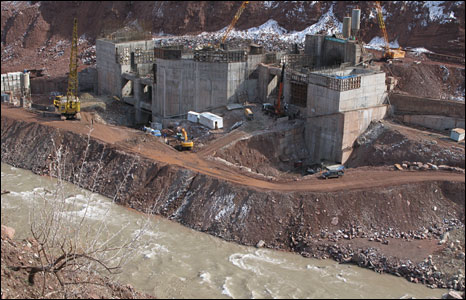
Tajikistan in 2012: A Year in Review
Publication: Eurasia Daily Monitor Volume: 10 Issue: 7
By:

The past year was an eventful one in Tajikistan on the economic, political and military fronts, with both domestic and regional ramifications. Importantly for Tajikistan’s economy, in May 2012, construction on the controversial hydroelectric Rogun Dam on the Vaksh River—a tributary of the Amu Darya river—was suspended following an order from the World Bank. The suspension reportedly put 5,000 people out of work and will remain in effect until the ecological impact study of the dam is completed. It is expected that the Word Bank’s feasibility study will be published this summer. Rogun is commonly seen to be at the heart of the hostility between Tajikistan and downstream Uzbekistan, which fears that the dam would severely damage Uzbekistani farmers’ ability to irrigate their cotton crops and would accelerate the ecological disaster in the Aral Sea. Uzbekistan has retaliated by periodically not allowing Tajikistan-bound rail and truck cargo to cross its borders and cutting off the flow of natural gas, exacerbating Tajikistan’s perennial energy shortages (Ozodi, January 1).
The year 2012 did however bring some good news for Tajikistan’s hopes of energy security with the news of the discovery of potentially huge hydrocarbon reserves in the Bokhtar region. The find was announced earlier this summer by the Canadian firm Tethys Petroleum and was deemed credible enough to attract investment from both the French energy giant Total and China’s National Oil and Gas Exploration and Development Corporation (CNODC) (Asia Plus, December 24, 2012). While further exploration needs to be done, the potential reserves of oil and gas are estimated to be more than enough to make Tajikistan a net exporter of hydrocarbons. Such a development would free Dushanbe from its energy reliance on Russia and Uzbekistan and no doubt influence its foreign policy calculations.
In December, Tajikistan joined the World Trade Organization, which local economists hope will lower domestic customs tariffs, curb the power of monopolies in certain sectors such as aviation, lower prices on domestic goods, and encourage foreign investment (BBC Tajik, December 11, 2012). On the other hand, some critics have raised concerns over the potential negative short-term effects on the competitiveness of Tajikistan’s two chief exports, aluminum and cotton. The country’s cotton industry is not only an important economic force but, given the continued existence in Tajikistan of Soviet-style collective farms (kolkhozy), an important socio-political institution as well.
On the political front, the big story looming in 2013 is the presidential election slated for November. The election will mark the first in Tajikistan since 2006 when Emomalii Rahmon secured his third term in office. That vote was boycotted by several opposition parties including the largest, the Islamic Renaissance Party (IRP). However, this time the opposition parties are expected to participate and possibly put forth a coalition candidate. Nonetheless, 2012 was a rough year for the opposition as both religious and political figures such as Muhiddin Kabiri (the head of the IRP) and Hoji Akbar Turajonzoda (prominent cleric and former deputy prime minister) were legally harassed, imprisoned (such as Umarali Quvatov, businessman and head of the exiled opposition group “Group 24”), and even killed (notably, Sabzali Mamadrizoev, head of the IRP in the remote Gorno-Badakhshan region). Since the last presidential vote in 2006, Rahmon has seen neighboring states and allies embroiled in contested elections and subsequent hostility (witness Iran’s 2009 presidential election, the 2010 coup in Kyrgyzstan as well as the Arab Spring uprisings in 2011–2012). Despite assurances from some quarters that the country’s civil war has bred a war-weary and politically disinterested population, the regime will likely increase the pressure on the opposition and consolidate its power during the run-up to the elections in anticipation of potential unrest. President Rahmon may attempt to secure his rule by exaggerating the threat of Islamic extremism and proffering himself as a bulwark against regional instability in the context of a post-2014 Afghanistan. However the unrest this summer in Tajikistan’s Gorno-Badakhshan that killed dozens was a sobering reminder of at least three things: 1) not all Tajikistanis are war weary, 2) not all threats to the regime are inspired by Islam, and 3) the regime underestimates the domestic and international backlash against such heavy-handed tactics.
On the foreign relations front, in October, Russia and Tajikistan ended a protracted and contentious negotiation over the extension of Russian basing rights in the country. In the end, Russia’s lease on military facilities in Tajikistan—home to the 201st Motorized Rifle Brigade—was extended for 30 years in exchange for the liberalization of the rules governing Tajikistani migrant workers in Russia and the cancellation of customs taxes on Russian gasoline imports to Tajikistan. While Rahmon was widely criticized at home for not brokering a more equitable deal (such as the one Kyrgyzstan secured for the extension of the lease on the Kant air base), Tajikistan’s fragile economy, which relies heavily on remittances from migrant workers in Russia and which cannot easily absorb predatory hikes in gasoline customs, did not leave Rahmon with many cards to play.
In 2012 Tajikistan also increased its cooperation with the North Atlantic Treaty Organization (NATO) by becoming a functioning cog in the Northern Distribution Network (NDN) into Afghanistan. However mountainous terrain and poor infrastructure have meant that the majority of goods traveling along the NDN still enter Afghanistan via Uzbekistan, and lucrative local procurement deals are more likely to go to the more industrialized Turkmenistan. Still, if Tajikistan can successfully woo more NDN-related business, such an accomplishment could serve as a boost to its economy as well as a means of counterbalancing Russian influence. As NATO operations in Afghanistan gear down in 2013, it will be interesting to see how many used supplies (including military hardware) find a new home in Central Asia. Consequently, although the NDN does have potential positive effects on the infrastructure and economies of these states, there is also the potential that the zero-sum nature of the influx of cash and supplies could exacerbate rivalries between both local business elites and the governments in Tashkent and Dushanbe.




